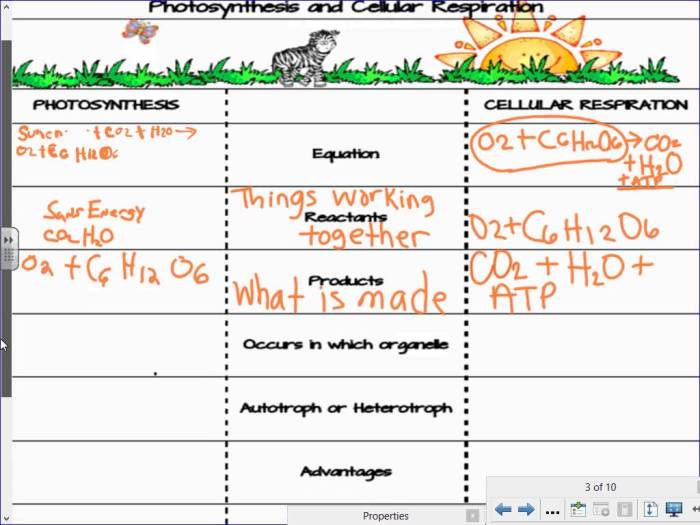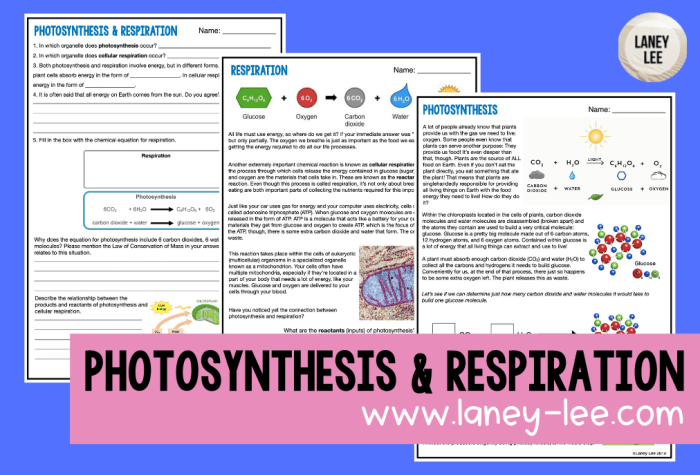Embark on a captivating journey into the realm of life’s essential processes with the photosynthesis and cellular respiration color by number answer key. This comprehensive guide unveils the intricate mechanisms that sustain all living organisms, empowering you with a profound understanding of the natural world.
Through engaging visuals and detailed explanations, this answer key illuminates the key stages, reactants, products, and energy transformations involved in both photosynthesis and cellular respiration. Dive into the fascinating world of chlorophyll, explore the conversion of light energy into chemical energy, and unravel the complexities of glycolysis, the Krebs cycle, and the electron transport chain.
Photosynthesis and Cellular Respiration Processes
Photosynthesis and cellular respiration are two fundamental processes in living organisms. Photosynthesis is the process by which plants and other organisms use sunlight to convert carbon dioxide and water into glucose and oxygen. Cellular respiration is the process by which organisms use glucose to produce energy.
The following table compares the key stages, reactants, products, and energy changes involved in photosynthesis and cellular respiration:
| Process | Key Stages | Reactants | Products | Energy Changes |
|---|---|---|---|---|
| Photosynthesis | Light-dependent reactions, Light-independent reactions | Carbon dioxide, Water | Glucose, Oxygen | Light energy converted into chemical energy |
| Cellular Respiration | Glycolysis, Krebs cycle, Electron transport chain | Glucose | Carbon dioxide, Water, ATP | Chemical energy in glucose converted into ATP |
Light-Dependent and Light-Independent Reactions in Photosynthesis: Photosynthesis And Cellular Respiration Color By Number Answer Key
Light-Dependent Reactions
The light-dependent reactions of photosynthesis take place in the thylakoid membranes of chloroplasts. Chlorophyll and other pigments absorb light energy, which is used to split water molecules into hydrogen and oxygen. The hydrogen is used to reduce NADP+ to NADPH, and the oxygen is released as a waste product.
Light-Independent Reactions
The light-independent reactions of photosynthesis take place in the stroma of chloroplasts. The NADPH and ATP produced in the light-dependent reactions are used to convert carbon dioxide into glucose. This process is known as the Calvin cycle.
Glycolysis, Krebs Cycle, and Electron Transport Chain in Cellular Respiration
Glycolysis, Photosynthesis and cellular respiration color by number answer key
Glycolysis is the first stage of cellular respiration. It takes place in the cytoplasm of cells. In glycolysis, glucose is broken down into two molecules of pyruvate. This process produces a small amount of ATP and NADH.
Krebs Cycle
The Krebs cycle is the second stage of cellular respiration. It takes place in the mitochondria of cells. In the Krebs cycle, pyruvate is further broken down into carbon dioxide. This process produces a large amount of ATP, NADH, and FADH2.
Electron Transport Chain
The electron transport chain is the third and final stage of cellular respiration. It takes place in the inner mitochondrial membrane. In the electron transport chain, NADH and FADH2 are used to pump protons across the inner mitochondrial membrane. This creates a proton gradient, which is used to drive the synthesis of ATP.
ATP Production and Energy Yield

ATP is the energy currency of cells. It is used to power all cellular activities, including muscle contraction, protein synthesis, and cell division.
The net energy yield of photosynthesis is 38 ATP molecules per molecule of glucose. The net energy yield of cellular respiration is 36 ATP molecules per molecule of glucose.
Interconnections between Photosynthesis and Cellular Respiration

Photosynthesis and cellular respiration are complementary processes. Photosynthesis produces the glucose that is used in cellular respiration. Cellular respiration produces the carbon dioxide that is used in photosynthesis.
These two processes are essential for the survival of life on Earth. Photosynthesis provides the oxygen that we breathe and the food that we eat. Cellular respiration provides the energy that we need to live.
Ecological Significance of Photosynthesis and Cellular Respiration

Photosynthesis
Photosynthesis is essential for the maintenance of the Earth’s atmosphere. It removes carbon dioxide from the atmosphere and releases oxygen. This helps to regulate the Earth’s temperature and climate.
Cellular Respiration
Cellular respiration contributes to the decomposition of organic matter and the cycling of nutrients. This process helps to recycle nutrients back into the environment, where they can be used by plants and other organisms.
Applications and Importance
Photosynthesis
Photosynthesis has a wide range of applications in agriculture and biotechnology. For example, it is used to improve crop yields and to develop new biofuels.
Cellular Respiration
Cellular respiration is important in medical research and drug development. For example, it is used to study the causes of diseases and to develop new treatments.
Q&A
What is the primary function of chlorophyll in photosynthesis?
Chlorophyll absorbs light energy, which is essential for the conversion of carbon dioxide and water into glucose.
How many stages are involved in cellular respiration?
Cellular respiration consists of three main stages: glycolysis, the Krebs cycle, and the electron transport chain.
What is the role of ATP in cellular processes?
ATP serves as the primary energy currency in cells, providing the energy required for various cellular functions.